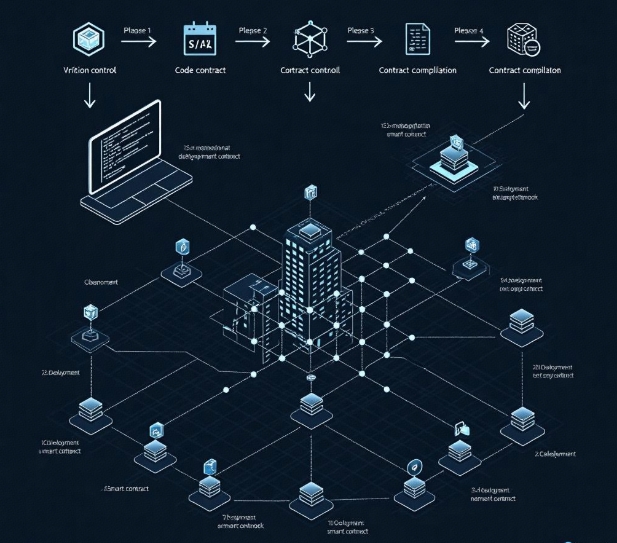How to Deploy DApps and Manage Smart Contracts
- latest articles
- 1.DApp Development & Customization: Merging Diverse Market Needs with User Experience 2.Analysis of the Core Technical System in DApp Project Development 3.How to achieve cross-chain interoperability in Web3 projects? 4.How does the tokenization of points reconstruct the e-commerce ecosystem? 5.How to Set and Track Data Metrics for a Points Mall? 6.What is DApp Development? Core Concepts and Technical Analysis 7.Inventory of commonly used Web3 development tools and usage tips 8.Development of a Distribution System Integrated with Social E-commerce 9.Six Key Steps for Businesses to Build a Points Mall System 10.What is DApp Development? A Comprehensive Guide from Concept to Implementation
- Popular Articles
- 1.Future Trends and Technology Predictions for APP Development in 2025 2.Analysis of the DeFi Ecosystem: How Developers Can Participate in Decentralized Finance Innovation 3.From Zero to One: How PI Mall Revolutionizes the Traditional E-commerce Model 4.DAPP Development | Best Practices for Professional Customization and Rapid Launch 5.Recommended by the Web3 developer community: the most noteworthy forums and resources 6.From Cloud Computing to Computing Power Leasing: Building a Flexible and Scalable Computing Resource Platform 7.How to Develop a Successful Douyin Mini Program: Technical Architecture and Best Practices 8.Shared Bike System APP: The Convenient Choice in the Era of Smart Travel 9.How to Create a Successful Dating App: From Needs Analysis to User Experience Design 10.From Design to Development: The Complete Process of Bringing an APP Idea to Life
With the rapid development of blockchain technology, decentralized applications (DApps) have gradually become a focus of attention. DApps are not just simple applications; they achieve decentralized automation and transparency through smart contracts within the blockchain network. The decentralized nature of blockchain allows DApps to operate without intermediaries, interacting directly with users and other contracts. In this article, we will detail how to deploy DApps and manage smart contracts, helping developers understand this process and providing some practical experience.
I. Basic Concepts of DApps
1.1 Introduction to DApps
Decentralized Applications (DApps) are applications built on blockchain technology. Unlike traditional centralized applications, DApps run on the blockchain through smart contracts and eliminate intermediaries, achieving true decentralization. The frontend of a DApp is typically similar to traditional web applications and can be accessed via a browser, but the backend relies on the blockchain platform for storage and computation. Since the backend of a DApp is decentralized, it ensures data transparency, immutability, and user privacy protection.
1.2 Introduction to Smart Contracts
Smart contracts are computer programs that run on a blockchain network. They are self-executing, self-verifying, and automatically enforce contract terms. The execution of smart contracts does not require intermediary intervention; all transactions and agreements are executed and verified by the code and the blockchain itself. Smart contracts are typically written by developers and deployed through specific blockchain platforms (such as Ethereum).
II. Architecture Design of DApps
Before deploying a DApp, it is essential to understand its architecture. A typical DApp consists of two parts: the frontend and the backend.
2.1 Frontend
The frontend is the part of the DApp that interacts with users. It is typically composed of HTML, CSS, and JavaScript, similar to the frontend technologies of traditional web applications. To enable the DApp to interact with the blockchain, the frontend often uses JavaScript libraries (such as Web3.js or Ethers.js) to connect to the blockchain.
2.2 Backend
The backend runs on the blockchain. It typically includes smart contracts, storage, and computation components. Smart contracts run on the blockchain network and provide business logic, while the storage component manages data through the blockchain's distributed ledger. The computation part is usually performed off-chain, processed by nodes or external servers.
2.3 Interaction with the Blockchain
The frontend connects to the blockchain through libraries like Web3.js or Ethers.js. These libraries help developers interact with smart contracts, send transactions, query states, and call functions.
III. Development and Deployment of Smart Contracts
3.1 Writing Smart Contracts
Smart contracts are typically developed using programming languages like Solidity (for the Ethereum platform) or Vyper. Taking Solidity as an example, it is a programming language oriented towards the Ethereum Virtual Machine (EVM), supporting the creation and operation of contracts. The process of writing a smart contract includes the following steps:
Define Contract Structure: First, define the structure of the contract, including state variables, constructors, public functions, etc.
Write Contract Logic: Next, write the specific logic of the contract based on the DApp's requirements, such as fund transfers, data storage, user authentication, etc.
Test the Contract: After writing the contract, perform unit tests to ensure its functionality is correct and to avoid potential vulnerabilities and errors.
Compile the Contract: Use the Solidity compiler to compile the smart contract into bytecode and Application Binary Interface (ABI) for deployment to the blockchain.
3.2 Deploying Smart Contracts
Deploying a smart contract requires sending the compiled bytecode to the blockchain network. On the Ethereum platform, the process of deploying a smart contract is as follows:
Select Deployment Network: Developers can choose to deploy on the Ethereum mainnet, testnets (such as Ropsten or Rinkeby), or a local network (such as Ganache). To reduce risks and costs, it is recommended to deploy and test on a testnet first.
Configure Wallet: Developers need to configure an Ethereum wallet (such as MetaMask) and transfer ETH into it to pay for the gas fees required for contract deployment.
Use Deployment Tools: Use deployment tools (such as Truffle or Hardhat) or libraries like Web3.js or Ethers.js to deploy the smart contract to the blockchain. The contract bytecode and ABI must be provided during deployment.
Verify the Contract: After deployment, developers can verify whether the smart contract was successfully deployed using a blockchain explorer (such as Etherscan).
3.3 Managing and Updating Smart Contracts
Once a smart contract is deployed to the blockchain, it cannot be altered. Therefore, the code of a smart contract should undergo thorough review and testing before deployment. However, if upgrades or modifications are needed, the following methods can be considered:
Proxy Contract Pattern: By using the proxy contract pattern, the contract logic can be upgraded without changing the original contract address. A proxy contract is typically a simple contract responsible for forwarding requests to the actual contract implementation.
Multi-Version Contract Management: Necessary modifications can be made in a new contract version, and then user funds or states can be migrated to the new contract. This method requires careful handling of data migration and compatibility issues between contracts.
IV. Security and Optimization of DApps
The security of DApps is crucial, especially when involving financial transactions and data processing. Developers should focus on the following aspects:
5.1 Security of Smart Contracts
Security vulnerabilities in smart contracts can lead to financial losses or exploitation by attackers. To ensure the security of smart contracts, developers can take the following measures:
Code Auditing: Conduct rigorous code audits before deploying smart contracts to identify potential vulnerabilities and risks.
Use Open-Source Contract Libraries: Utilize widely validated open-source contract libraries (such as OpenZeppelin) to avoid reinventing the wheel.
Prevent Reentrancy Attacks: Take measures to prevent reentrancy attacks when handling external calls.
5.2 Frontend Security of DApps
Frontend security is equally important. Developers should ensure the protection of user data and transaction information:
Prevent XSS Attacks: Use strict input validation and Content Security Policy (CSP) to prevent cross-site scripting attacks.
Prevent CSRF Attacks: Implement appropriate authentication mechanisms to prevent cross-site request forgery attacks.
Encrypt Communication: Ensure all requests interacting with the blockchain and users are encrypted via HTTPS.
5.3 Performance Optimization
The performance of DApps is also crucial, especially when blockchain interactions are frequent. Developers can improve DApp performance through the following methods:
Reduce Complexity of Contract Calls: Minimize the computational load of each contract call to reduce gas fees.
Use Caching Appropriately: Avoid frequent blockchain queries and reduce unnecessary network requests through caching techniques.
Optimize Frontend Performance: Use frontend performance optimization techniques, such as code splitting and lazy loading, to enhance user experience.
V. Conclusion
Deploying DApps and managing smart contracts is a complex but highly promising process. By learning how to write smart contracts, deploy them to the blockchain, interact with the frontend, and ensure the security and performance optimization of DApps, developers can create efficient, secure, and reliable decentralized applications. As blockchain technology continues to evolve, the potential and application scenarios of DApps will expand further. Developers should stay updated on new trends and technological advancements in this field.
-

DApp Development & Customization: Merging Diverse Market Needs with User Experience
As blockchain technology matures and becomes more widespread, decentralized appl···
-

Analysis of the Core Technical System in DApp Project Development
With the rapid development of blockchain technology, decentralized applications ···
-

What is DApp Development? Core Concepts and Technical Analysis
With the rapid development of blockchain technology, decentralized applications ···

 Blockchain
Blockchain












